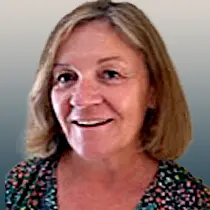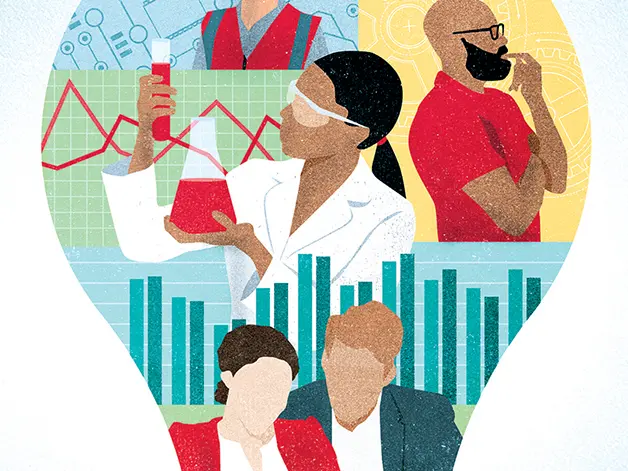Where I Live: It’s a great time to see Seattle
Water is the star in this city, both what you can do on and around it and the tasty meals that can come from it. Also not to be missed: local museums and out-of-town day trips.

Seattle Buckeyes, from left, Justin Berger, Nathan Bingman, Laura Smales Garner and Claudius Mbemba enjoy their city’s eclectic waterfront. (Photo by Jovelle Tamayo)
This time of year, Seattleites get a little boastful about their city. “There’s nowhere better to be in the world,” says Nathan Bingman ’08. “It’s probably one of the prettiest places you can be in the summer,” adds John Hamilton ’84. But hey, declares Claudius Mbemba ’15, “it’s not bragging if it’s true.”
What more could you want? “The water’s blue, the sky is blue,” says Justin Berger ’08, and there are plenty of both. Most summer days you can see all the way to Mount Rainier, 100 miles away. And Seattle is awash with salt and fresh water, thanks to Puget Sound and Lake Union, among other bodies of water that flow through and around the city.
The Washington State Ferry is a great way to get onto the water. With or without a car, people can hitch a half-hour ride from Seattle to Bainbridge Island. “Getting out to see the city from the water is just magnificent,” Hamilton says, and watching the skyline light up in the evening “becomes almost magical.”
If a ferry isn’t your taste, you can take your cue from Manish Engineer ’00, whose favorite way to be on the water is a small electric motorboat “almost the size of a golf cart.” You can rent one on Lake Union or Lake Washington and bring your own food and drink. “It’s an easy, very accessible thing to do,” Engineer says.
Or you can follow the lead of Laura Smales Garner ’12, ’12. She likes to rent kayaks on Lake Union, especially from Agua Verde, near the University of Washington. Bonus: Agua Verde offers a waterfront Mexican restaurant.
From there, Garner chooses between paddling the shoreline of the Washington Park Arboretum, past the houseboat of Tom Hanks’ character in “Sleepless in Seattle” or beside Gas Works Park, former site of a gasification plant that features both ruins and a play area for families.
Engineer’s favorite park is the city’s largest, Discovery Park, which includes miles of trails high above Puget Sound. Visitors can hike along the shore and down to a beach and lighthouse. The only downside, he says, is the uphill return trek, “but I think the trip is worth it.”
Just as you’ll want to find a way onto the water, you don’t want to miss what’s in the water: the fish, of course. Summer through September is peak time for watching the salmon migrate up the fish ladder at Hiram M. Chittenden Locks, known to locals as Ballard Locks. Boat gazing, fish watching and exploring 7 acres of botanical gardens near the locks draw more than a million visitors a year.

Bingman, Mbemba, Berger and Garner visit the famed Pike Place Market. (Photo by Jovelle Tamayo)
To see the salmon a step closer to the plate, visit Pike Place Market downtown, which Laurie Hamilton ’84 calls “historic Seattle.” In addition to all the stalls of produce, flowers and crafts, as well as the original Starbucks, you’ll want to check out Pike Place Fish Market, where staff heave fish to one another for visitors’ amusement.
If you’re ready to sit down and dine, Ray’s Boathouse gets the nod from several Buckeyes. Ray’s features fresh seafood, “overlooks the sound and has beautiful sunsets,” Engineer says. Garner identifies it as “a Seattle staple.”
Berger often craves Seattle’s sushi. He recommends Shiro’s in the Belltown neighborhood or Momiji in Capitol Hill. “If you want a really good seafood sandwich, there’s a place over in Ballard” called Un Bien, Garner says. “They do a Caribbean sandwich.”
Need a break from fish? Search out the “secret gem” of Thalia Cronin ’19, ’19: El Taco Loco. Of the restaurant’s two locations, she prefers the one tucked in a liquor store in Ballard.
You can’t go thirsty in Ballard, home to “20-plus breweries, all with different types of beer, and they’re all family-friendly,” Engineer says. Bingman and Cronin both claim Reuben’s Brews as a favorite.
Cronin also likes to hoist a mug at Outlander Brewing in nearby Fremont. Outlander prides itself on experimentation, Cronin says, adding, “We’ll go back and it’s a whole new menu.”
Of course, part of the draw is the neighborhood itself. Cronin and Berger fondly describe Fremont as “quirky,” and the 18-foot troll statue under George Washington Memorial Bridge says that in stone. If you’ve seen the movie “Ten Things I Hate About You,” you’ve caught a glimpse of the iconic troll.
Quirky, progressive, casual, innovative — all adjectives Buckeyes use to describe their Northwest home.
“There’s a lot to do — mountains for hiking, the water, the fresh air,” Mbemba says. “It’s just different out here.”
Get a full picture in local museums
Seattle’s history, culture and pride are on display in the city’s plentiful museums, and visits to even a few offer a flavor of Seattle’s past and present.
Laura Smales Garner recommends first-time visitors start with the Museum of History and Industry, or MOHAI, “if you want to know about Seattle’s roots. The best part is they have a musical [exhibit] about the Great Seattle Fire [of 1889].”
Flight has played such an integral part in Seattle’s history — Boeing was established here in 1916 — that a stop at the Museum of Flight pairs well with MOHAI. The museum houses more than 175 aircraft and spacecraft, allowing visitors to explore everything from a reproduction of the Wright brothers’ 1903 flyer to a model of Boeing’s lunar roving vehicle.

At the Museum of Flight, airplanes dwarf visitors. (Getty Images)
Seattle Buckeyes agree that the bold, colorful sculptures of Chihuly Garden and Glass are a must-see. Besides an exhibition hall showcasing the work of Tacoma native Dale Chihuly, the galleries include a garden installation and glasshouse. While there, you can take a ride up the famed Space Needle.
For those who think grunge whenever they think Seattle, the Museum of Pop Culture is waiting. It’s a “fun, unique” museum full of music memorabilia, Nathan Bingman says. Exhibits cover Pearl Jam, Nirvana, Jimi Hendrix and even video games, the focus of more than 70 Seattle-area companies.
Seattle in a nutshell
The Washington State Ferry system transports millions of people — with and without vehicles — each year. The largest U.S. ferry system, it carried more than 17 million customers in 2021, about 72% of its pre-pandemic total, reports the Washington State Department of Transportation.
Seattle is home to the world’s longest floating bridge, connecting the city to its Bellevue and Kirkland suburbs. The SR 520 Floating Bridge measures 7,710 feet, and almost half of it is floating.
Edward E. Carlson drew what would become the Space Needle, symbol of the 1962 World’s Fair, on a cocktail napkin in the late ’50s. Ultimately it was built to withstand a 9.1 magnitude earthquake and 200-mph winds.
While one of Seattle’s nicknames is “Rain City,” it gets an average of only 39 inches of rain each year. That’s less than Houston (53 inches), Atlanta (52 inches), New York (47 inches), Boston (47 inches) and just a smidge less than Columbus (40 inches).
Interested in getting out of Seattle?
For those planning to spend some time in the area, we surveyed the Alumni Club of Seattle to find out great spots for day trips. Sharing their favorites were Matt Fenstermaker ’13, Peter Fitzgerald ’77, Dorinda Otto ’76 and Laura Smales Garner ’12, ’12.
Here are 10 trips to consider:
Bremerton
Accessible from a scenic ferry ride of almost an hour, downtown Bremerton offers lots of shops, restaurants and Bremerton Fountain Park, a great place to wade and cool off. There is also a U.S. Navy base and mothball fleet, with the famous USS Turner Joy docked next to the ferry terminal and open for tours.
Chuckanut Drive
Chuckanut Drive provides many gorgeous hikes at Bellingham Bay. One great day trip is hiking the Oyster Dome, a moderate hike with beautiful views in the Chuckanut Mountains, followed by a meal at Taylor Shellfish Farms. There you can enjoy a tray of local oysters as well as Manila clams, Mediterranean mussels and a selection of local fish, Dungeness Crab and scallops.
Lake Chelan
About 150 miles east of Seattle, this deep glacier-fed lake boasts beautiful scenery, fishing and hiking. Usually drier and warmer than Seattle, the area is a destination for wine tasting, camping, touring — you name it.
Leavenworth
Two-and-a-half hours from Seattle sits this Bavarian-style village in the Cascade Mountains. It sports Alpine-like buildings, restaurants serving German beer and food, and nearby ski areas and wineries. Christmastime is one of the most popular seasons to visit, and the town goes all out with an annual tree lighting ceremony, carolers and horse-drawn sleigh rides.
Mount Rainier loop
This is a full-day drive around Mount Rainier, the iconic volcano in Washington state. The views and hikes are incredible, and early in the season there is usually plenty of snow at the Paradise Visitor Center.
Poo Poo Point
Located 18 miles east of downtown in Issaquah, Poo Poo Point is a convenient intro to hiking in the Northwest. Metro bus service from Seattle takes visitors to the trailhead during the summer. There they can start the 4-mile round-trip hike, which has an elevation gain of almost 2,000 feet and beautiful views of Mount Rainier, Lake Sammamish, Mount Baker and the Olympics. Poo Poo Point is also a hot spot for local parasailing, which is fun to watch, and the adventurous can usually book a ride on the spot — and avoid the hike back to the parking lot.
Port Townsend
This is a full-day ferry/drive trip to a beautiful turn-of-the-century town on the waterfront. It boasts many shops and restaurants, beautiful Victorian homes and buildings, and Fort Worden State Park. Bicycle and kayak rentals are also available.
San Juan Islands
This is the best place to go in the summer or anytime of year. You take a ferry to one of the islands (San Juan and Orcas have the most options for overnight stays). There you can find whale watching, kayaking, hiking, wine, beer, oysters and more great food in a breathtakingly gorgeous setting.
Snoqualmie Falls
Twenty-nine miles east of Seattle, off Interstate 90 at exit 25, is the Snoqualmie Falls. At 270 feet tall, this easy-to-access water feature has upper and lower observation decks that are free and open every day of the year. There is a trail down to the bottom of the falls, nearby Salish Lodge and an ice cream stand.
Tacoma Museum of Glass and Point Ruston
Like Toledo, Ohio, the Pacific Northwest has a wealth of glassmaking history. One of our most famous artists is Dale Chihuly. He helped create the Chihuly Bridge of Glass that crosses over a busy thoroughfare to the entrance of the Museum of Glass in Tacoma. The inspiring ceiling of the bridge is similar to his installation at the Bellagio Hotel in Las Vegas. The museum itself is fascinating with a huge room where creating glass objects is open for all to watch the process. After the visit, take a drive to Point Ruston’s Dune Peninsula at Point Defiance Park. It is a place that inspired the “Dune” world, where its creator Frank Herbert was born. Enjoy trails and views of the south Puget Sound.
Join the club
Many of the Buckeyes interviewed for this story are active in the Alumni Club of Seattle.
Catch up with them at seattle.alumni.osu.edu.



